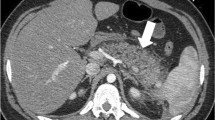Summary.
Lethality and morbidity of blunt abdominal trauma are directly dependent on the immediately valid diagnostic work-up. Since blunt abdominal trauma usually occurs in the setting of multisystem injury and patients are no longer cooperative, clinical methods of diagnosis are unreliable. In regard to the imaging procedures, the practical approach has been simplified and standardized in the last few years. Initially, ultrasonography of the abdomen is performed. If the patient is hemodynamically unstable because of intra-abdominal loss of blood, this can be reliably detected by ultrasound and emergency laparotomy is indicated. If patients are hemodynamically stable, more sophisticated assesment of the abdomen can be achieved by computed tomography. The next step depends on direct or indirect signs of an intra-abdominal lesion. Angiography may be indicated in injuries to the liver, spleen, kidney, mesenteric root or caval vein. If lesions to the liver, biliary or pancreas are detected, ERCP may be required. Lacerations of hollow organs are identified by fine-needle aspiration of free intra-abdominal fluid. Findings on computed tomography are usually reliable enough to support a more conservative approach in the treatment of parenchymal lesions in blunt abdominal trauma. Since the facilities to perform ultrasound are provided in all emergency units and knowledge of ultrasonography is an essential part of surgical training, competitive diagnostic procedures like peritoneal lavage have completely lost their former important clinical role. Similarly, diagnostic laparoscopy is – in contrast to abdominal perforations – no longer of importance.
Zusammenfassung.
Mortalität und Morbidität des stumpfen Bauchtraumas hängen direkt von der rechtzeitigen, korrekten Diagnosestellung ab. Da in der überwiegend Zahl der Fälle Begleitverletzungen vorliegen und die Patienten häufig nicht (mehr) kommunikations- bzw. kooperationsfähig sind, ist die klinische Diagnostik unzuverlässig. Bezüglich der weiteren, bildgebenden Diagnostik wurde das praktische Vorgehen in den letzten Jahren vereinfacht und weitgehend vereinheitlicht: Initial erfolgt die Ultraschalldiagnostik des Abdomens. Bei Patienten, die aufgrund eines Blutverlusts in das Abdomen kreislaufinstabil geworden sind, kann diese Ursache immer sonographisch entdeckt und damit gleichzeitig die Indikation zur Notfalllaparotomie gestellt werden. Bei kreislaufstabilen Patienten wird zur weiteren Feindiagnostik des Abdomens bei nicht ganz eindeutigem Ultraschallbefund die computertomographische Untersuchung (CT) des Abdomens angeschlossen. Vom Nachweis direkter oder indirekter Zeichen einer Läsion hängt das weitere Vorgehen ab und kann u. a. die Angiographie (Leber, Milz, Niere, Mesenterialwurzel, V. cava), die endoskopisch-retrograde Cholangio-Pankreateographie (ERCP) (Leber, Gallenwege Pankreas) bzw. die Punktion von freier intraabdominaler Flüssigkeit umfassen, wodurch Verletzungen von Hohlorganen diagnostiziert werden können. Die heute recht zuverlässige computertomographische Diagnostik des stumpfen Bauchtraumas stellt darüberhinaus eine wesentliche Voraussetzung für die heute immer deutlichere Tendenz zur konservativen Behandlung von Parenchymläsionen beim stumpfen Bauchtrauma dar. Da die Möglichkeit der Ultraschalldiagnostik heute praktisch in jedem Versorgungskrankenhaus gegeben ist und die sonographische Diagnostik fester Bestandteil der chirurgischen Ausbildung ist, sind konkurriende Verfahren wie die diagnostische Peritoneallavage praktisch bedeutungslos geworden. Auch die diagnostische Laparoskopie hat – im Ggs. zum Perforationstrauma – keinen aktuellen Stellenwert.
Similar content being viewed by others
Author information
Authors and Affiliations
Rights and permissions
About this article
Cite this article
Feussner, H., Papaziogas, W. & Siewert, J. Moderne Diagnostik des stumpfen Bauchtraumas. Chirurg 70, 1246–1254 (1999). https://doi.org/10.1007/s001040050776
Issue Date:
DOI: https://doi.org/10.1007/s001040050776




